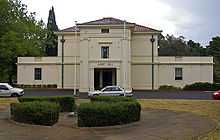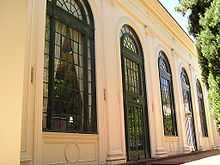Albert Hall, Canberra



The Albert Hall is a hall in Canberra, Australia, used for entertainment. It is on Commonwealth Avenue between Commonwealth Bridge and the Hotel Canberra in the suburb of Yarralumla.
Overview
The hall was opened on 10 March 1928 by the Prime Minister, Stanley Bruce. Bruce named the hall, explaining at the opening ceremony that he had chosen the name from the Royal Albert Hall in London and also because it was the first name of The Duke of York (later George VI) and furthermore that it commemorated the "Consort of the Queen who had proclaimed the Australian Commonwealth".
The hall was originally designed by the Federal Capital Commission architect David Limburg, under Chief Architect Henry Rolland, then amended before construction. It is in the Federal Classical style. A porte-cochere at the front allows for passengers from vehicles to alight undercover. The hall was not heated in its early years, and patrons had to bring rugs, thick coats and water bottles. Singers were known to perform in fur coats until heating was finally installed after World War II.[1]
Prior to its construction, the largest hall in the Federal Capital Territory was at the Causeway in Kingston. Until the completion of the Canberra Theatre in 1965, the Albert Hall was the only place in Canberra for audiences of more than 700 people other than the cinemas.
The Albert Hall remains the 'city hall' for Australia's national capital, used for civic, cultural and community functions and with some commercial use. It is heavily booked on weekends and during the week for private events, dances, balls, performances, cultural activities and commercial sales.
Heritage and Development Controversy
On 22 February 2007, the National Capital Authority (NCA) released National Capital Draft Amendment 53 - Albert Hall Precinct. This amendment to the development plans for the city was intended to reinstate some of the plans that were originally made by Walter Burley Griffin when he designed the city in 1912, which had been neglected in the years following Griffin's departure from Canberra, when the Albert Hall was constructed. The plan intended to reinforce the geometry, landscape and purpose of the area surrounding the Albert Hall, including Commonwealth Avenue in front of the hall, and the open space facing Lake Burley Griffin at its rear. In particular, the amendment suggested that the land around the Albert Hall would be opened up for commercial purposes such as cafes and tourist facilities. The amendment also made reference to a 'landmark building' north of Albert Hall, which would presumably house these facilities.[2]
There was a lot of discussion about the plans outlined in the amendment. An action group formed to oppose the plan, under the emotive catch-cry of "Save Albert Hall". Ongoing public debate and anger directed towards the authorities involved led to the National Capital Authority holding public meetings on 5 March, and later added more meetings on 22 and 24 March. Finally, at a meeting on 2 April 2007, it was agreed that the NCA would not proceed with the landmark building, and that the land would be used as a "public lakeside park".[3] The organisation continues to campaign to protect the Albert Hall and its precinct. The building, which was previously listed only on the Heritage Places register, has been suggested for inclusion on the National Heritage List, which would make it extremely difficult for government authorities to make further attempts to develop the precinct. In the lead-up to the 2007 Federal Election, the Labor Senator Kate Lundy committed $500,000 to the restoration of the Albert Hall.
Compton Theatre Organ
A Compton Theatre Organ was installed in Albert Hall in the late 1980s, after the ACT Division of the Theatre Organ Society of Australia took delivery of its components and spent almost ten years restoring the organ. Its inaugural concert was on 17 August 1986, with organist Tony Fenelon. This organ had originally been, from March 1933 until 1968, in the Gaumont Palace (later renamed the Odeon Theatre) in Cheltenham, Gloucestershire, UK.[4]
References
- Wigmore, Lionel (1963). The long view: a history of Canberra, Australia's National Capital. F.W. Cheshire, Melbourne, Australia. (no ISBN).
- Sites of Significance in the ACT, volume two, Inner Canberra. National Capital Development Commission, Canberra, Australia. 1988. ISBN 0-642-13229-1.
Footnotes
- ↑
- Exploring the ACT and Southeast New South Wales, J. Kay McDonald, Kangaroo Press, Sydney, 1985, p42 ISBN 0-86417-049-1
- ↑ National Capital Draft Amendment 53 - Albert Hall
- ↑ DA53 Authority Decision
- ↑ History of the Canberra Compton Organ, Theatre Organ Society of Australia ACT Division, accessed 6 December 2008
External links
- ACT Government - Albert Hall information
- Australian National University Archives: Albert Hall, Yarralumla, Canberra
- Environment ACT: Albert Hall
- A History of Albert Hall from the ACT Library
- Albert Hall: Entry for the ACT Heritage Register (pdf)
- Our Albert Hall
| ||||||||||||||||||
Coordinates: 35°17′51″S 149°07′30″E / 35.297623°S 149.125135°E